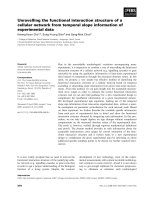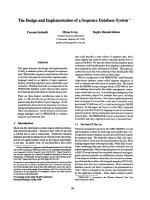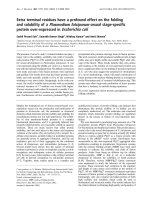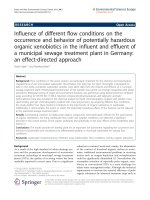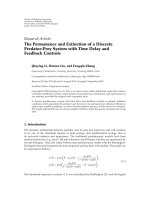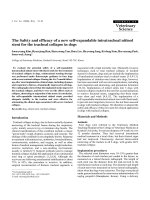The meating and structure of a science fiction story: A susysemic functinonal analysis
Bạn đang xem bản rút gọn của tài liệu. Xem và tải ngay bản đầy đủ của tài liệu tại đây (195.19 KB, 18 trang )
T¹p chÝ Khoa häc ®hqghn, ngo¹i ng÷, T.xxI, Sè 2, 2005
The meaning and structure of a science fiction
story: a sysyemic functional analysis
Hoang Van Van(*)
grammar and meaning of a science fiction
story as a text. The procedures and
conventions used in the analysis are based
on the framework of Halliday’s (1994) An
Introduction to Functional Grammar;
Halliday and Hasan’s (1985) Language,
Text and Context: Aspect of Language in
Social-Semiotic Perspective; Hasan’s (1984)
Coherence and Cohesive; and Butt’s (1984)
The Theme and Lexico-Grammar in the
Poetry of Wallace. The analysis will
proceed from the context of the chosen
text; clauses and clause complexes
analysis; the transitivity pattern, the mood
pattern, the theme-rheme pattern, the
grammatical and lexical cohesion analyses
for the cohesive harmony of the text; to a
summary of the context of situation of the
text in terms of the three contextual
parameters: field, tenor and mode.
1. Introduction
What is a text? To a layman, a text
may be just a text or it may be “I’ve got no
idea”. To the people in the linguistics circle
who are not concerned with language as
social semiotic, a text may be a rather
fuzzy and abstract term, or it may mean “a
body of printed or written work” as defined
by the Collins English Dictionary (1990).
To the etymologist, a text may carry a
general meaning of texture, because, as
they may explain, “text” is derived from
the Latin word “textus” meaning “texture”.
But what is linguistic texture is still
another problem.
It may be inappropriate to ask second
or foreign language teachers such a big
question. If the question is given to them, I
am sure, the polite answer will be “Sorry,
we are language users, we are not
concerned with language theory. What
we’re supposed to do is to use and teach
language correctly and appropriately, and
nothing else.” Fortunately, the “correctly”
and the “appropriately” in their answer
have a lot to do with text, and to
understand what a text is will certainly
help them a great deal in their teaching
(for detail of this point, see Halliday,
McIntosh and Strevens 1964, Halliday and
Hasan 1985, and Burns 1990).
2. The Context of the Chosen Text
This text is taken from an English
textbook Streamline English: Connection
published by Cambridge University Press
in 1983. The title of the text is A Science
Fiction Story indicating its genre. Above
the text there is a picture in which there
are a man and a woman sitting in a forest
of a new planet. Behind them there is a
spaceship. There are two astronauts’ helmets,
one in front of them and the other at their
back. They are holding a fruit in their hands.
The woman is looking at the man.
With these difficulties in mind, in this
paper, an attempt is made to explore the
(*)
Assoc.Prof.Dr., School of Graduate Studies - VNU.
28
The meaning and structure of a science fiction story: A sysyemic...
29
3. Clauses and Clause Complexes Analysis
The analysis of the text into clauses and clause complexes and their logico-semantic relations
can be done as follows:
(1) ||The spaceship flew around the new planet several times. (2) || The planet was
blue and green. (3) ||| They couldn’t see the surface of the planet (4) || because there
were too many white clouds. (5) ||| The spaceship descended slowly through the clouds
(6) || and landed in the middle of a green forest. (7) ||| The two astronauts put on
their spacesuits, (8) || opened the door, (9) || climbed carefully down the ladder, (10)
|| and stepped on to the planet.|||
(11) || The woman looked at a small control unit on her arm. (12) ||| “It’s all right,”
(13) || she said to the man. (14) ||| “We can breathe the air ... (15) || it’s a mixture of
oxygen and nitrogen.” (16) ||| Both of them took off the helmets (17) || and breathed
deeply.|||
(18) || They looked at everything carefully. (19) || All the plants and animals looked new and
strange. (20) || They couldn’t find any intelligent life. (21) || After several hours, they returned to
their spaceship. (22) || Everything looked normal. (23) ||| The man switched on the controls, (24)
|| but nothing happened. (25) ||| “Something’s wrong,” (26) || he said, (27) || “I don’t
understand... (28) || the engines aren’t working.” (29) ||| He switched on the computer, (30) ||
but that didn’t work either. (31) ||| “Eve”, he said, (32) || “we are stuck here (33) ||... we can’t
take off!” |||
(34) ||| “Don’t worry, Adam,” (35) || she replied. (36) || “They’ll rescue us soon.” |||
The analysis shows that the text
XVI which read as “It’s all right,” she said
consists of 36 clauses which make up 18
to the man. “We can breathe the air... it’s a
clause complexes. Most of the clauses in
mixture of oxygen and nitrogen.” and
the clause complexes are in paratactic
“Something’s wrong,” he said. “I don’t
relation showing their interdependence.
understand... the engines aren’t working.”
Their semantic relations are mainly of
It is the conventional full stop in writing
elaboration and expansion. Four clause
that causes argument. The full stop in
complexes (VII, XV, XVII, XVII) are of
writing here suggests that there may be
quoting and quoted relation characterising
two clause complexes in each. In this
the dialogic portion of the text. There is
paper, all the four clauses are combined
only one clause complex (III) which has
into one clause complex, representing
hypotactic relation. One more thing that
one semantic structure in the writer’s
should be commented upon here concerns
own thinking. This is shown in Table 1
the division of clause complexes VII and
below.
T¹p chÝ Khoa häc §HQGHN, Ngo¹i ng÷, T.XXI, Sè 2, 2005
Hoang Van Van
30
Table 1. Clauses and Clause Complexes
(1)
1
II
III
(2)
1
(3)
1
2
||
1.1
||
||
1. 1
||
|||
α
1α
|| x
β
1β
||
IV
V
VI
VII
VIII
IX
X
XI
XII
XIII
XIV
(5)
1
2
(7)
1
2
3
4
(11)
1
(12)
1
2
3
4
(16)
1
2
(18)
1
(19)
1
(20)
1
(21)
1
(22)
1
(23)
1.1
|||
|||
|| +
1.2
|||
|| =
1.2
|| =
1.1
||
1.1
||
||| ”
1.1
||
|||
1.1
|| +
||
1.1
||
||
1.1
||
||
1.1
||
||
1.1
||
||
1.1
||
1.2
1.2
|| =
1.3
1.3
|| =
|| =
1.4
1.4
|||
|||
|||
T¹p chÝ Khoa häc §HQGHN, Ngo¹i ng÷, T.XXI, Sè 2, 2005
The meaning and structure of a science fiction story: A sysyemic...
1
2
XV
(25)
1
2
3
4
XVI
(29)
1
2
XVII (31)
1
2
3
XVIII (34)
1
2
3
|||
1.1
||| ”
||
|| x
1.1
1.1
1.2
31
|||
||
1.2
|| =
|| x
1.2
||
1.3
|| =
||| ”
1.1
||
1.2
|| =
1.3
||
|||”
1.1
||
1.2
|| =
1.3
|||
Boundary Markers used for the analysis:
|||: Clause complex boundary
||: Clause boundary
•
Type of dependence
1.1
1.2
1.3
...:
Paratactic relation
α
β
…: Hypotactic relation
• Logico-semantic relations
= : Elaboration
+ : Extension
x : Enhancement
” : Projection / locution (wording)
• Others:
I, II, III ...: Number of clause complex in the whole text
(1), (2), (3) ...: Number of clause in the whole text
1, 2, 3 ...: Number of clause within a clause complex
T¹p chÝ Khoa häc §HQGHN, Ngo¹i ng÷, T.XXI, Sè 2, 2005
1.4
|||
Hoang Van Van
32
4. Transitivity Pattern
The text is a narrative about the two
astronauts landing in a new planet for the
first time. The “what is going on?” of the
text is well represented in the experiential
component of meaning. From the point of
view of transitivity, of the 36 clauses 17
are material process (flew in 1, descended
in 5, landed in 6, put on in 7, opened in 8,
climbed in 9, stepped in 10, took off in 16,
returned in 21, switched on in 23,
happened in 24, aren’t working in 28,
switched on in 29, didn’t work in 30, are
stuck in 32, and take off in 33). These are
used to describe the motion of the
spaceship (1, 5, and 6) and the physical
actions of the actors; 6 are mental process
(couldn’t see in 3, looked at in 11, looked at
in 18, couldn’t find in 20, don’t understand
in 27, and don’t worry in 34) characterising
the perception and feeling of the
characters when they land in the new
planet; and 7 are relational and existential
processes (was in 2, were in 4, ’s in 12, ’s in
15, looked in 19, looked in 22, and ’s in 25)
positing that things are in existent and
describing the state of being of the things
under the observation of the astronauts in
the new planet.
Most of the processes are in the simple
past tense (25/36). They are used in the
narrative portion. The present simple
(9/36), the present continuous (1/36), and
the simple future (1/36) are used in the
dialogic portion, characterising the actions
which occurred, is occurring and will occur
at the moment of the characters’ speaking.
The circumstantial components in the
clauses of the text are of manner (slowly,
carefully, deeply), location (around the
planet, here, in the middle of the green
forest), and direction (through the cloud).
The transitivity pattern of the text is
represented in Table 2.
Table 2. Transitivity Pattern of the Text
Clause
Participa
Process
Participant 2
Circumstances
(nt 1)
I
1
Actor
II
2
Carrier
relational was
III
3
Senser
mental see
4
Existent
relational were
5
Actor
material descended
6
Actor
material landed
7
Actor
material put on
Goal
8
Actor
material opened
Goal
9
Actor
material climbed
10
Actor
material stepped
11
Senser
mental looked at
12
Carrier
relational ’s
Attribute
13
Sayer
verbal said
Target
14
Behaver
behavioural breath
Range
15
Carrier
relational ’s (is)
Attribute
16
Actor
material took off
Goal
IV
V
VI
VII
VIII
material flew
Location
Frequency
Manner
Direction
Phenomenon
Location
Manner
Location
Location
Phenomenon
Location
T¹p chÝ Khoa häc §HQGHN, Ngo¹i ng÷, T.XXI, Sè 2, 2005
The meaning and structure of a science fiction story: A sysyemic...
33
17
Behaver
behavioural breathed
IX
18
Senser
mental looked at
X
19
Carrier
relational looked
Attribute
XI
20
Senser
mental find
Phenomenon
XII
21
Actor
material returned
XIII
22
Carrier
relational looked
Attribute
XIV
23
Actor
material switched on
Goal
24
Actor
material happened
25
Carrier
relational ’s (is)
26
Sayer
verbal said
27
Senser
mental understand
28
Actor
material working
29
Actor
materialswitched on
30
Actor
material work
31
Sayer
verbal said
32
Goal
material are stuck
33
Actor
material take off
XV
XVI
XVII
XVIII
Manner
Phenomenon
Manner
Direction
Attribute
Location
mental worry
34
35
Sayer
verbal replied
36
Actor
material rescue
Goal
simple past tense, while in the dialogic
5. The Mood Pattern
The “Who is taking part?” of the text is
presented in its mood patterns. In terms of
speech function, one can see the two role
relationships, one is between the writer
portion, they are combined with a variety
of tenses such as the simple present (is,
are),
the
present
continuous
(aren’t
working), and the future simple (will).
and the reader(s), and the other between
There are very few modal elements
the characters themselves. The analysis
used in the text. Only 4 clauses contain
shows that most of the Subjects in the
modality. Two of them express the writer’s
clauses of the text are personal. Apart
judgement about the characters’ inability
from the fictional features presented by
to perform the actions (they couldn’t in 3
borrowing the two imaginary characters
and they couldn’t in 20). Two others
from the Bible (Eve and Adam), the science
express
fiction features worded in the nominal
inability to perform the actions (can’t in 14
groups which are placed in the subject
and can’t in 33). Of 36 clauses, 35 are in
position
terms
the declarative mood, which is one of the
(astronaut, planet, spaceship, computer,
typical features of a narrative. The mood
control unit ...). The finite elements in the
pattern of the text is represented in
narrative portion are combined with the
Table 3.
are
modern
science
T¹p chÝ Khoa häc §HQGHN, Ngo¹i ng÷, T.XXI, Sè 2, 2005
the
characters’
(as
subject)
Hoang Van Van
34
Table 3. Mood Pattern of the Text
Clause
I
II
III
IV
V
VI
VII
VIII
IX
X
XI
XII
XIII
XIV
XV
XVI
XVII
XVIII
1
2
3
4
5
6
7
8
9
10
11
12
13
14
15
16
17
18
19
20
21
22
23
24
25
26
27
28
29
30
31
32
33
34
35
36
Subject
The spaceship
The planet
They
There
The spaceship
The two astronauts
The woman
It
She
We
It
Both of them
They
All plants and Animals
They
They
Everything
The man
Nothing
Something
He
I
The engines
He
That
We
He
We
She
They
6. The Theme-Rheme Pattern
Finite
flew
was
couldn’t
were
descended
landed
put
opened
climbed
stepped
looked
is
said
can
’s (is)
took
breathed
looked
looked
couldn’t
returned
looked
switched
happened
’s (is)
said
don’t
aren’t
switched
didn’t
are
said
can’t
don’t
replied
’ll (will)
Mood
declarative
declarative
declarative
declarative
declarative
declarative
declarative
declarative
declarative
declarative
declarative
declarative
declarative
declarative
declarative
declarative
declarative
declarative
declarative
declarative
declarative
declarative
declarative
declarative
declarative
declarative
declarative
declarative
declarative
declarative
declarative
declarative
declarative
imperative
declarative
declarative
Modality
ability/neg.
ability/pos.
ability/neg.
ability/neg.
ability/neg.
complexes analysed for theme, 17 have
Our analysis shows that most of the
unmarked theme and 4 have marked
themes in the text belong to the plane of
theme. At the beginning of the text,
ideational component (that is, topical
inanimate nouns as theme predominate
theme).
(spaceship in 1, planet in 2, and spaceship
Of
21
clauses
and
clause
T¹p chÝ Khoa häc §HQGHN, Ngo¹i ng÷, T.XXI, Sè 2, 2005
The meaning and structure of a science fiction story: A sysyemic...
35
in 5), then they are shifted to animate
calls “thematic progression” in the text,
nouns (astronaut, man, and woman) and
though
the third person participant (she, he, and
consistent: (Rheme 1 → Theme 2 (in
they) revealing the development of the
clauses 1 and 2); Theme 1 → Rheme 2 (in
story. 4 clause complexes contain textual
clauses 2 – 3); Rheme 1 → Rheme 2 (in
theme (III, VIII, XIV, and XVI); and of the
clauses 4 – 5); Rheme 1 → Theme 1 (in
4 marked theme, 3 are in the dialogic
clauses 16 = 17 – 18); Theme 1 → Theme 2
portion expressing the logical relations of
(in clauses 20 – 21); and Rheme 1 →
addition
is
Theme 2 (in clauses 29 – 30). This is the
interesting is that although there are
method of text development to carry the
dialogic portions in the text, there are no
narrative forward and it is what Halliday
interpersonal themes. This suggests that
[2, 1994] calls “the text with a stepwise
the text may be written to be read or told.
structure.” The Theme-Rheme pattern of
There is a kind of what Danes [7, 1974]
the text can be represented in Table 4.
and
enhancement.
What
this
pattern
is
not
always
Table 4. The Theme-Rheme Pattern of the Text
Clause
Textual
Interpersonal
Theme
Theme
Topical Theme
Markedness
of Theme
I
1
The spaceship
unmarked
II
2
the planet
unmarked
III
3
They
unmarked
There
unmarked
The spaceship
unmarked
4
IV
5
6
V
VI
VII
VIII
because
and
(ellipsis)
7
The two astronauts
8
(ellipsis)
9
(ellipsis)
10
(ellipsis)
11
The woman
unmarked
12
It’s all right
marked
13
(ellipsis)
14
(ellipsis)
15
(ellipsis)
16
both of them
17
and
T¹p chÝ Khoa häc §HQGHN, Ngo¹i ng÷, T.XXI, Sè 2, 2005
(ellipsis)
unmarked
unmarked
Hoang Van Van
36
IX
18
they
unmarked
X
19
All the plants an animals
unmarked
XI
20
they
unmarked
XII
21
After several hours
marked
XIII
22
Everything
unmarked
XIV
23
The man
unmarked
Nothing
unmarked
25
Something’s wrong
marked
26
(ellipsis)
27
(ellipsis)
28
(ellipsis)
24
XV
XVI
XVII
XVIII
29
30
but
He
unmarked
that
unmarked
31
He said
unmarked
32
33
(ellipsis)
but
34
35
36
7. The Cohesion of the Text
7.1. Grammatical Cohesion
According to Halliday and Hasan
(1976), there are four main types of
grammatical cohesive devices: reference,
ellipsis, substitution, and conjunction. It
should be noted here that there are very
few conjunctive devices in the text.
Therefore, although they are analysed,
they are not discussed in detail in this
exercise. The analysis of the grammatical
cohesive devices of the text is based on the
frameworks of Butt’s [5,1984], Halliday
[2,1994], Halliday and Hasan [10,1976]. It
focuses mainly on the different types of
(ellipsis)
Don’t worry
marked
(ellipsis)
(ellipsis)
reference such as anaphoric, cataphoric,
exophoric,
personal
reference,
and
demonstrative reference. Table 5 presents
a detailed account of all grammatical
cohesive devices found in the text. The
first column enunciates the cohesive
devices,
the
second
contains
interpretative sources, the third states
the phoric status of the tie, and the last
presents the chain relation in terms of
the address of all the preceding members
in the chain. Tables 6 and 7 summarise
the total number of references, the
number of clauses, the number of
cohesive ties in the text and the number
of ties per clause.
T¹p chÝ Khoa häc §HQGHN, Ngo¹i ng÷, T.XXI, Sè 2, 2005
The meaning and structure of a science fiction story: A sysyemic...
37
Table 5. Grammatical Cohesive Devices of the Text
Cohesive
Devices
The (planet)
Interpretative
Devices
1. planet
Ties
Status
anaphoric
Chain
2 –1
exophoric
they
the (surface)
3. planet
cataphoric
3–3–2–1
the (planet)
2. planet
anaphoric
3–2–1
the (spaceship)
1. spaceship
anaphoric
5 –1
the (clouds)
3. clouds
anaphoric
5–3
the (middle)
6. forest
cataphoric
6–6
the (astronauts)
3. they
anaphoric
7–3
their
7. astronauts
anaphoric
7–7–3
the (door)
exophoric
the (ladder)
exophoric
the (planet)
3. planet
anaphoric
10 – 3 – 2 – 1
exophoric
the (woman)
her (arm)
11. woman
anaphoric
11 – 11
It
11. unit
anaphoric
12 – 11
she
11. woman
anaphoric
13 – 11
exophoric
the (man)
we
7. astronauts
anaphoric
14 – 7
exophoric
the (air)
It
14. air
anaphoric
15 – 14
them
14. astronauts
anaphoric
16 – 14 – 7 – 3
their
16. astronauts
anaphoric
16 – 16 – 14 – 7 – 3
they
16. astronauts
anaphoric
18 – 16 – 14 – 7 – 3
exophoric
the (plants)
they
18. astronauts
anaphoric
20 – 18 – 16 – 14 – 7 – 3
they
20. astronauts
anaphoric
21 – 20 – 18 – 16 – 14 – 7 – 3
their
21. they
anaphoric
21 – 21 – 20 – 18 – 16 – 14 – 7– 3
the (man)
13. man
anaphoric
23 – 13
exophoric
the (controls)
he
23. the man
anaphoric
26 – 23 –13
I
26. the man
anaphoric
27 – 26 – 23 – 13
exophoric
the (engines)
he
26. the man
anaphoric
T¹p chÝ Khoa häc §HQGHN, Ngo¹i ng÷, T.XXI, Sè 2, 2005
29 – 27 – 26 – 23 – 13
Hoang Van Van
38
the (computer)
exophoric
that
29. the computer
anaphoric
30 – 29
he
29. the man
anaphoric
31 – 29 – 27 – 26 – 23 – 13
we
21. astronauts
anaphoric
32 – 21 – 21 – 20 – 18 – 16 – 7 – 3
we
32. astronauts
anaphoric
33–32– 21– 21– 20– 18–16 – 7 – 3
she
13. the woman
anaphoric
they
35 – 13 – 11
exophoric
us
33. astronauts
Table 6
anaphoric
36-33- 32- 21- 21- 20- 18- 16- 7- 3
Table 7
Total number of reference: 44
Number of clauses:
Anaphoric reference:
Number of cohesive ties: 43
Exophoric reference:
Cataphoric reference:
29
13
Number of tie per clause:
36
1. 02
2
As shown in Table 6, the number of exophoric reference is 13 / 44. This suggests that
the text is not highly self-sufficient, and that it may be part of a larger text. In contrast, the
data in Table 7 may suggest that the text is highly cohesive. The grammatical cohesive
devices of the text can be displayed as follows:
A Science Fiction Story
The spaceship flew around the new planet several times. The planet was blue
R:D
R:D
R:D
and green. They couldn’t see the surface of the planet because there were too
R:P
R:D
R:D
many white clouds. The spaceship descended slowly through the clouds and
R:D
R:D
landed in the middle of a green forest. The two astronauts put on their space
R:D
R:D
R:P
suits, opened the door, climbed carefully down the ladder, and stepped onto the
R:D
R:D
R:D
planet. The woman looked at a small control unit on her arm. “It”s all right,’ she
R:D
R:P
R:D
R:P
T¹p chÝ Khoa häc §HQGHN, Ngo¹i ng÷, T.XXI, Sè 2, 2005
The meaning and structure of a science fiction story: A sysyemic...
39
said to the man. “We can breathe the air... it’s a mixture of oxygen and
R:P
R:P
R:D
nitrogen.’ Both of them took off their helmets and breathed deeply.
R:P
R:P
They looked at everything carefully. All the plants and animals looked new and
R:P
R:D
strange. They couldn’t find any intelligent life. After several hours, they
R:P
R:P
returned to their spaceship. Everything looked normal. The man switched on the
R:P
R:D
controls, but nothing happened. “Something’s wrong,” he said, “I don’t
R:P
R:P
understand... the engines aren’t working.’ He switched on the computer, but
R:D
R:P
that didn’t work either. “Eve,” he said, “we are stuck here ... we can’t take off!”
R:D
R:P
R:P
R:D
R:P
“Don’t worry, Adam,” she replied. “They’ll rescue us soon.”
R:P
R:P
R:P
Notes:
R:D: Demonstrative reference
Cataphoric reference
R:P:
Personal reference
Anaphoric reference
Exophoric reference
Anaphoric and exophoric reference
T¹p chÝ Khoa häc §HQGHN, Ngo¹i ng÷, T.XXI, Sè 2, 2005
Hoang Van Van
40
7.2. Lexical Cohesion
• new (1, 19)
Lexical Chains
• green (2, 6), blue (2), white (4)
The lexical cohesion analysis is based
on Halliday and Hasan’s (1976) and
Hasan’s (1984) procedures. The analysis
focuses on such lexical cohesive ties as
repetition, antonym, meronym, synonym,
syper-ordinate hyponym, and collocation.
The analysis of these parameters is
represented in Table 8. The Roman
numerals state the clause number in
which the lexical tokens occur. Following
Table 8, Table 9 presents the scores in
terms of chain per clause, token per clause,
tie per chain, and tie per clause.
• several (1, 21)
• times (1), hours (21)?
• carefully (9, 18)
• everything (18, 22)
• flew (1), descended (5), landed (6),
stuck (32), take off (33)
• put on (7), took off (17)
• see (3), looked at (11), looked (18, 19,
23), find (20)
• switched on (23, 29)
• climbed (7), stepped (10)
• spaceship (1, 4, 21), door (8), ladder
(9), control (23), engine (27), computer (20)
• working (28), work (30)
• planet (1, 2, 3, 10), forest (6), plants
(19), animals (19), life (28)
• breathed (14, 17)
• astronauts (7, 8, 9, 10), woman/Eve
(11), man/Adam (13, 23)
• air (14), oxygen (15), nitrogen (15)
• said (19, 26), replied (35)
From the analysis we can see that
the total number of chains is 18 with 66
tokens and 67 ties. Table 9 summarises
the scores.
Table 9
chain/clause
token/cl.
token/chain
tie/chain
tie//clause
0.50
1.9
3. 7
3.7
1.9
Lexical Relations
The spaceship flew around the new planet several times. The planet was blue
REP
and green. They couldn’t see the surface of the planet because there were too
ANT
MER
REP
REP
many white clouds. The spaceship descended slowly through the clouds and
ANT
REP
COL
REP
landed in the middle of a green forest. The two astronauts put on their space
COL
REP MER
REP
suits, opened the door, climbed carefully down the ladder, and stepped onto the
MER
MER
SYN
T¹p chÝ Khoa häc §HQGHN, Ngo¹i ng÷, T.XXI, Sè 2, 2005
The meaning and structure of a science fiction story: A sysyemic...
41
planet.
REP
The woman looked at a small control unit on her arm. ‘It’s all right,’ she said to
HYP
SYN
MER REP
the man. “We can breathe the air ... it’s a mixture of oxygen and nitrogen.” Both
HYP
MER
MER
of them took off their helmets and breathed deeply.
ANT
REP
They looked at everything carefully. All the plants and animals looked new and
REP
REP
REP REP
strange. They couldn’t find any intelligent life. After several hours, they
SYN
REP
returned to their spaceship. Everything looked normal. The man switched on the
REP
REP
REP
REP
controls, but nothing happened. “Something’s wrong,” he said, ‘I don’t
MER
REP
REP
understand... the engines aren’t working.” He switched on the computer, but
MER
REP
MER
that didn’t work either. “Eve,” he said, “we are stuck here ... we can’t take off!”
REP
REP
REP
REP ANT
REP
ANT
“Don’t worry, Adam,” she replied. “They’ll rescue us soon.”
REP
ANT
REP
Notes:
REP = repetition
SYN = synonym
ANT = antonym
HYP = hyponym
MER = meronym
COL = collocation
7.3. Chain Interactions
The chain interactions are represented in the diagram that follows. Because of the great
number of lexical chains and the complexity in each chain, it is not possible to get the
accurate scores. The analysis is done in terms of
(i) Relevant tokens: all those tokens that enter into identity or similarity chains; these
are divided into:
(a) Central tokens: those relevant tokens that interact;
(b) Non-central tokens: those tokens that do not interact;
T¹p chÝ Khoa häc §HQGHN, Ngo¹i ng÷, T.XXI, Sè 2, 2005
Hoang Van Van
42
(ii) Peripheral tokens: those tokens that do not enter into any kind of chain. The final
figures are summarised in Table 10.
Table 10. Chain interractions
astronauts (7)
astronauts (8)
(i)
↔
climbed (9)
stepped (10)
XVII
astronauts (9)
astronauts (10)
↔
put on (7)
took off (17)
XIV
astronauts (14)
astronauts (17)
↔
looked at (11)
looked at (18)
astronauts (18)
astronauts (19)
↔
looked (19)
looked (23)
↔
see (30
find (20)
astronauts (20)
astronauts (33)
astronauts (36)
XV
XX
woman (11)
woman (13)
IX
carefully
(9)
carefully
(18)
(i)
↔
XIX
said (19)
said (26)
(ii)
said (31)
man (13)
↔
said (35)
man (23)
breathe (14)
breathed (17)
↔
switched on (23)
woman (31)
woman (35)
man (29)
man (31)
spaceship (1)
spaceship (4)
spaceship (21)
↔
(i)
↔
switched on (29)
XVI
flew (1)
descended (5)
landed (6)
taker off (33)
stuck (32)
T¹p chÝ Khoa häc §HQGHN, Ngo¹i ng÷, T.XXI, Sè 2, 2005
The meaning and structure of a science fiction story: A sysyemic...
planet (1)
planet (2)
(iv)
↔
43
is (12)
is (15)
is (25)
green (2)
(iii)
planet (3)
was (2)
(v)
new (1)
green (6)
↔
planet (10)
were (4)
↔
new (19)
plants (19)
↔
animals (19)
blue (2)
forest (6)
white (4)
life (20)
aren’t (28)
are (31)
Table 10. Final Figures for Cohesive Harmony/Coherence
Total
RT
PT
CT
CT as % of TT
CT per PT
116
68
44
58
50%
1.035
Notes:
RT: relevant tokens
PT: peripheral tokens
CT: central tokens
It can be said at this point that the text under study is highly cohesive, and based on these
formal features it can also be concluded that the text has achieved both coherence and harmony.
7.4. Contextual Configuration of the Text
In the systemic functional model,
context is seen as an integral part of
language. According to Halliday (1978,
1994), given an adequate specification of
the semiotic properties of the context, one
can predict not everything, but still a great
deal about the language that will occur,
with reasonable probability of being right.
Context is characterised by three
parameters: field, tenor, and mode. These
features of the text under study can be
summarised as follows:
T¹p chÝ Khoa häc §HQGHN, Ngo¹i ng÷, T.XXI, Sè 2, 2005
1. Field
• A science fiction story written for
teaching purposes in the form of story-telling.
• Participant types: actors, sensers,
behavers, and sayers.
• Process types: predominantly material,
with past events characterising the feature
of narrative.
2. Tenor
• Writer and readers, with writer
adopting the role as recounter.
• Astronaut (male) and astronaut (female)
with information exchanging roles.
Hoang Van Van
44
• Mood: declarative in both narrative
and dialogic portion (except 1 in clause 34)
• Modality: ability on the part of the
characters.
3. Mode
•
Medium:
written;
channel:
combination of visual and graphic.
a
• Not highly sufficient (this fact is shown
in the number of exophoric references.
• High lexical density and parataxis
and low grammatical intricacy.
7.5. Concluding Remarks
In this article, I have been concerned
with the analysis of a science fiction story,
using systemic functional linguistics as the
theoretical framework. As can be seen from
the analysis, systemic functional linguistics is
a model of language which encompasses
levels of language – phonology, lexico-
grammar, and semantics – and the social
context in which language (communication)
occurs. Further, different from other
models of language such as TG, systemic
functional linguistics possesses a very rich
pool of analytical instruments which helps
researchers tackle not only phonological
but also grammatical (syntax), semantic
and discoursal problems of a text. “There
may be many roads to lead to Rome”, but
our analysis has shown very powerfully
that the systemic functional road can be
the best at least at the current state of
human knowledge. However, in order to
travel comfortably along this road, it is
recommended that the traveller study
the map (the theory), details of the road
(the analytical instruments) carefully. “A
thousand-mile journey often starts with
single steps.”
References
1.
Collins English Dictionary. Sinclair J. (Ed.), London: Harper Collins Publishers, 1990.
2.
Halliday, M. A. K., An Introduction to Functional Grammar, Second Edition, London:
Edward Arnold, 1994.
3.
Halliday, M. A. K., A., McIntosh and P. D. Strevens, The Linguistics Sciences and Language
Teaching, London: Longman, 1964.
4.
Halliday, M. A. K. and R. Hasan., Language, Context and Text: Aspect of Language in
Social-Semiotic Perspective. Geelong, Victoria: Deakin University Press, 1985.
5.
Butt, D. G. The Theme and Lexico-Grammar in the Poetry of Wallace, Unpublished PhD
thesis, Macquarie University, Sydney, Australia, 1984.
6.
Burns, M., Context of Competence: Social an Cultural Considerations in Communication
Language Teaching, New York: Plenum Press, 1990.
7.
Danes, F. (Eds.)., Papers on Functional Sentence Perspective, Prague: Acedemia
(Czechoslovak Academy of Sciences), 1974.
8.
Halliday, M.A.K., Language as Social Semiotic: the Interpretations of Language and
Meaning, London: Edward Arnold.
9.
Hasan, R., Coherence and Cohesive Harmony. (In) Flood, J. (Ed) Understanding Reading
Comprehesion: Cognition, Language and the Structure of Prose, 1984.
10. Halliday, M.A.K and R. Hasan., Cohesion in English, London: Longman, 1976.
T¹p chÝ Khoa häc §HQGHN, Ngo¹i ng÷, T.XXI, Sè 2, 2005
The meaning and structure of a science fiction story: A sysyemic...
45
VNU. JOURNAL OF SCIENCE, Foreign Languages, T.xXI, n02, 2005
Cấu trúc và ngữ nghĩa của một câu chuyện khoa học viễn
tởng: phân tích theo quan điểm chức năng
PGS.TS Hoàng Văn Vân
Khoa Sau Đại học, Đại học Quốc gia Hà Nội
Bài viết dự định phân tích một câu chuyện khoa học viễn tởng ngắn có nhan đề A
Science Fiction Story in trong giáo trình tiếng Anh Streamline English: Connection do
Oxford University Press xuất bản, sử dụng lí thuyết chức năng do Halliday và các nhà ngôn
ngữ học chức năng hệ thống khác phát triển. Bài viết bắt đầu bằng việc trả lời câu hỏi Thế
nào là văn/ngôn bản?. Sau đó bài viết cung cấp thêm một số chi tiết về ngôn cảnh trong đó
ngôn bản xuất hiện. Mục này đợc kế tiếp bằng việc phân tích toàn bộ câu truyện từ bốn
bình diện: chuyển tác, thức, đề ngữ, và liên kết, mỗi bình diện đợc phân tích, thống kê và
đợc thảo luận chi tiết. Bài viết quan tâm đặc biệt đến việc phân tích những sự tơng tác từ
vựng theo chuỗi để xem độ liên kết và độ mạch lạc của ngôn bản. Mục 7.4 trình bày những
nét khái quát về ngôn cảnh tình huống hình thành nên ngữ vực gọi là truyện khoa học viễn
tởng. Trong phần kết luận bài viết tóm tắt lại những nội dung chính đã trình bày và cố
gắng chỉ ra rằng ngôn ngữ học chức năng là một mô hình ngôn ngữ toàn diện với bộ công cụ
phân tích có thể sử dụng để phân tích các loại hình ngôn bản một cách hữu hiệu. Tuy nhiên,
để có thể phân tích đợc ngời phân tích nên nghiên cứu kĩ từng công cụ trong bộ đồ nghề
này. Một cuộc trờng chinh vạn dặm thờng bắt đầu bằng những bớc đơn lẻ.
Tạp chí Khoa học ĐHQGHN, Ngoại ngữ, T.XXI, Số 2, 2005



